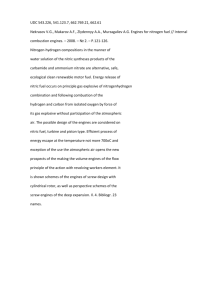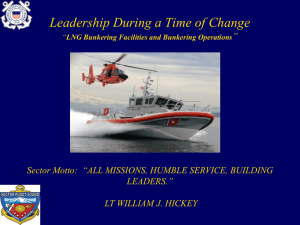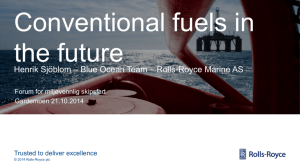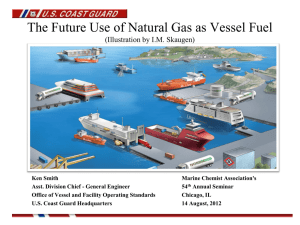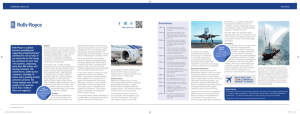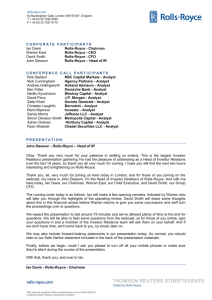Rolls-Royce Press Release Template
advertisement
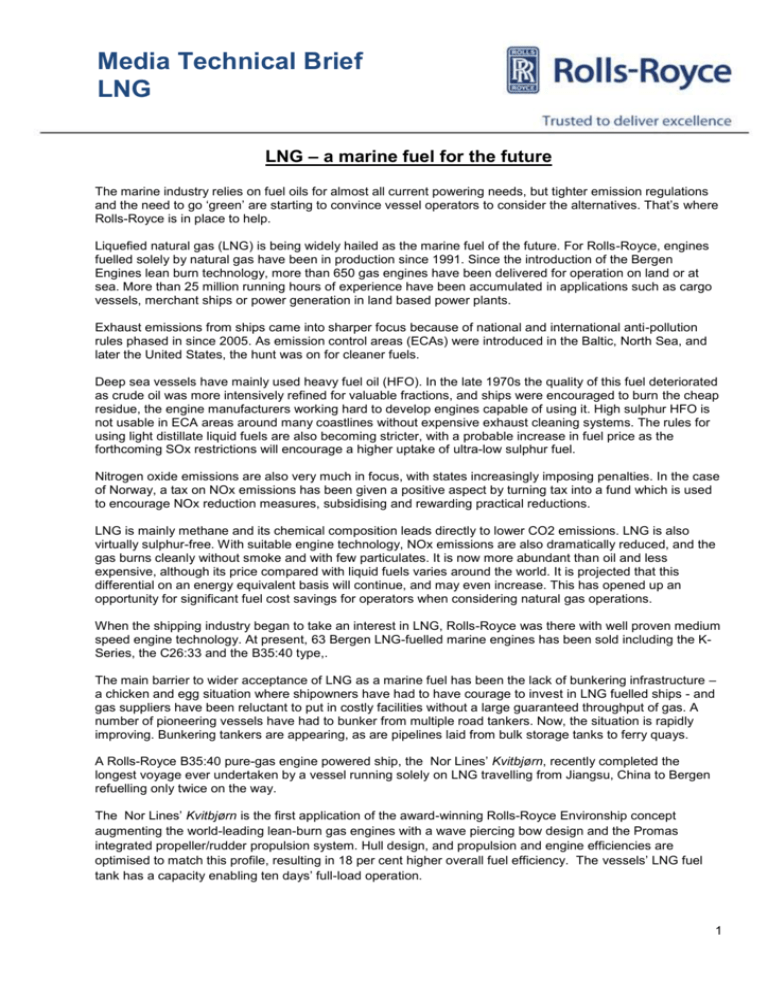
Media Technical Brief LNG LNG – a marine fuel for the future The marine industry relies on fuel oils for almost all current powering needs, but tighter emission regulations and the need to go ‘green’ are starting to convince vessel operators to consider the alternatives. That’s where Rolls-Royce is in place to help. Liquefied natural gas (LNG) is being widely hailed as the marine fuel of the future. For Rolls-Royce, engines fuelled solely by natural gas have been in production since 1991. Since the introduction of the Bergen Engines lean burn technology, more than 650 gas engines have been delivered for operation on land or at sea. More than 25 million running hours of experience have been accumulated in applications such as cargo vessels, merchant ships or power generation in land based power plants. Exhaust emissions from ships came into sharper focus because of national and international anti-pollution rules phased in since 2005. As emission control areas (ECAs) were introduced in the Baltic, North Sea, and later the United States, the hunt was on for cleaner fuels. Deep sea vessels have mainly used heavy fuel oil (HFO). In the late 1970s the quality of this fuel deteriorated as crude oil was more intensively refined for valuable fractions, and ships were encouraged to burn the cheap residue, the engine manufacturers working hard to develop engines capable of using it. High sulphur HFO is not usable in ECA areas around many coastlines without expensive exhaust cleaning systems. The rules for using light distillate liquid fuels are also becoming stricter, with a probable increase in fuel price as the forthcoming SOx restrictions will encourage a higher uptake of ultra-low sulphur fuel. Nitrogen oxide emissions are also very much in focus, with states increasingly imposing penalties. In the case of Norway, a tax on NOx emissions has been given a positive aspect by turning tax into a fund which is used to encourage NOx reduction measures, subsidising and rewarding practical reductions. LNG is mainly methane and its chemical composition leads directly to lower CO2 emissions. LNG is also virtually sulphur-free. With suitable engine technology, NOx emissions are also dramatically reduced, and the gas burns cleanly without smoke and with few particulates. It is now more abundant than oil and less expensive, although its price compared with liquid fuels varies around the world. It is projected that this differential on an energy equivalent basis will continue, and may even increase. This has opened up an opportunity for significant fuel cost savings for operators when considering natural gas operations. When the shipping industry began to take an interest in LNG, Rolls-Royce was there with well proven medium speed engine technology. At present, 63 Bergen LNG-fuelled marine engines has been sold including the KSeries, the C26:33 and the B35:40 type,. The main barrier to wider acceptance of LNG as a marine fuel has been the lack of bunkering infrastructure – a chicken and egg situation where shipowners have had to have courage to invest in LNG fuelled ships - and gas suppliers have been reluctant to put in costly facilities without a large guaranteed throughput of gas. A number of pioneering vessels have had to bunker from multiple road tankers. Now, the situation is rapidly improving. Bunkering tankers are appearing, as are pipelines laid from bulk storage tanks to ferry quays. A Rolls-Royce B35:40 pure-gas engine powered ship, the Nor Lines’ Kvitbjørn, recently completed the longest voyage ever undertaken by a vessel running solely on LNG travelling from Jiangsu, China to Bergen refuelling only twice on the way. The Nor Lines’ Kvitbjørn is the first application of the award-winning Rolls-Royce Environship concept augmenting the world-leading lean-burn gas engines with a wave piercing bow design and the Promas integrated propeller/rudder propulsion system. Hull design, and propulsion and engine efficiencies are optimised to match this profile, resulting in 18 per cent higher overall fuel efficiency. The vessels’ LNG fuel tank has a capacity enabling ten days’ full-load operation. 1 There is also a much deeper understanding of the safety aspects of using LNG as a marine fuel. It is a cryogenic liquid, but as natural gas it is lighter than air, it disperses easily and has a relatively narrow combustion envelope, between five and 15 per cent in air, making it difficult to ignite. Workable rules for vessel systems have been developed by classification societies and continue to be enhanced, while there is growing acceptance by state and port control authorities of bunkering with passengers on board ferries, necessary to reduce vessel turnaround times. For coastal and short sea services where emission control regulations are strictest, LNG is now widely accepted as an option, and interest in propulsion of large ships such as container vessels on deep sea routes is growing. Rolls-Royce gas engines have developed over several generations. The first into marine service was the K-G series, with most mechanical elements derived from the diesel engine. These engines were selected for a group of five double-ended ferries built in 2006/2007 to serve two links on the E39 highway in western Norway between Stavanger and Bergen. These Bergensfjord class ferries have two levels of installed power, and electric transmission, as one route called for 21 knots and the other 17 knots, to maintain the 30 minute departure frequency from each end. They have operated an intensive schedule, with no downtime due to LNG, for the past six years. The owners Fjord1 calculate a 25 per cent efficiency gain compared to a diesel ferry. As well as no visible exhaust emissions, the lube oil stays remarkably clean and there is no need to change it so regularly, a big plus point in terms of operating cost and waste disposal. These ferries do their job well, but much has been learned. When a sixth ferry, Boknafjord, entered the same service in 2012, it incorporated technology advances to make it more energy efficient. Improvements include a more efficient hull design and four Rolls-Royce Azipull thrusters. Gas electric propulsion is retained, but the engines are three Bergen C26:33 9cyl gas, with a Bergen C series diesel, so the ferry can sail in areas away from gas infrastructure if required. Larger Bergen gas engines complete the LNG portfolio, the B and BV series with 350mm bore and 400mm stroke. The Bergen marine gas engine power range is from 1,460kW to 5,700kW. Rolls-Royce gas engines have powered Fjord Line ferries Bergensfjord and Stavangerford to the top two positions in the World Ports Climate Environmental Ship Index (ESI). The liquefied natural gas (LNG) fuelled ferries are both powered by four Rolls-Royce BV12PG gas engines that drive highly efficient Rolls-Royce PROMAS integrated rudder and propellers. These ferries have achieved the top score in the index, which measured the emissions of over three thousand ships. Of the 3194 ships currently on the ESI list, Bergensfjord scored 93.9 points followed by sister vessel Stavangerfjord with 93.5. Only fifty vessels had a score higher than 49. Rolls-Royce has won an order from Chinese state oil company CNOOC, to power Asia's first gas powered tug. The order is for two tugs to be built at the Zhenjiang shipyard in Jiangsu, China, with an option for an additional two. The first tug is planned for delivery this summer Each tug features a pair of Rolls-Royce Bergen C26:33L9PG engines fueled purely by liquefied natural gas (LNG). The Rolls-Royce power and propulsion systems package for each tug includes a pair of highly reliable Rolls-Royce US 205 CP azimuth thrusters to ensure the tugs have rapid manoeuvring and strong bollard pull capabilities - essential for tug operation. Next to the medium speed Bergen gas engines portfolio Rolls-Royce also enters the marine market with a high speed engine solution. The Rolls-Royce Power Systems subsidiary MTU Friedrichshafen, Damen Shipyards of the Netherlands, and Denmark’s SVITZER have embarked on a pioneering project to bring the first ever Reverse Stern Drive (RSD)® Compressed Natural Gas (CNG) tug to the market. The new 16-cylinder pure gas engine being developed by MTU is based on its proven workboat Series 4000 M63 diesel engine. It will be complemented with a multipoint gas injection system, a dynamic engine control and an optimised safety concept. Developed to meet the extreme load profile of the tugboat, the acceleration will be comparable to MTU diesel engines. Due to the clean combustion concept, compliance with IMO Tier 3 emission legislation will be ensured without the need of additional exhaust gas after treatment. The 2,000 kW MTU gas engine is characterised by high power density combined with low fuel consumption. LNG can also be used for on board power generation. Rolls-Royce is supplying two all-gas Bergen B35:40V20AG engines for power generation on-board a Floating Liquefaction Vessel (FLNGV) owned by Golar LNG Ltd. The vessel Hilli was a former LNG carrier and is being converted to a FLNGV carrier. 2 For further information including pictures, please contact: Craig Taylor Head of Communications – Marine Rolls-Royce m: +44 (0) 7807 969 426 e: craig.taylor2@rolls-royce.com 3

